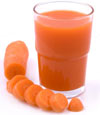Vitamin A
Vitamin A is essential for maintaining bones, teeth, skin, mucous membranes, reproduction, and vision. Because it is an antioxidant, vitamin A may reduce the risk of some forms of cancer. It helps to improve vision and boost the immune system.
How Much Vitamin A Do You Need?
The Recommended Dietary Amount (RDA) or Daily Value for vitamin A is 900 micrograms a day for males, 700 for women. The upper limit reccommended is not more than 3,000 micrograms.
What Happens If You Don't Get Enough Vitamin A?
Deficiency in vitamin A can lead to night blindness, dry eyes and skin, and a reduction in the secretion of the mucous membranes.
What Happens If You Get Too Much Vitamin A?
An overdose of vitamin A can restrict growth and stop menstruation. Too much vitamin A can also lead to skin rashes, jaundice, nausea, headaches, and damaged red blood corpuscles.

Good Sources of Vitamin A
The human body can manufacture vitamin A from the carotene found in vegetables, or humans can consume vitamin A that has already been manufactured by animals through cheese, milk, egg yolk, liver, and butter. The following chart outlines some of the best sources of vitamin A. Vegetables labeled cooked are cooked from frozen (unless otherwise stated), not canned or fresh. Frozen vegetables retain more of the vitamin compared to fresh than do canned vegetables.
| Good Sources of Vitamin A |
| Food | Serving | Amount* |
| Liver (from meat) | 3 oz | 1,490+ |
| Carrot Juice | 3/4 cup | 1692 |
| Sweet Potatoes (baked with peel) | 1 medium | 1,096 |
| Pumpkin | 1/2 cup | 953 |
| Carrots (cooked from fresh) | 1/2 cup | 671 |
| Spinach (cooked) | 1/2 cup | 573 |
| Collard Greens (cooked) | 1/2 cup | 489 |
| Kale (cooked) | 1/2 cup | 478 |
| Carrots (raw) | 1 small | 301 |
| Winter Squash (cooked) | 1/2 cup | 268 |
| Cantaloupe | 1/4 a melon | 233 |
| Sweet Peppers (cooked) | 1/2 cup | 186 |
| *micrograms Retinol Activity Equivalents (RAE) of vitamin A |
» Discount Vitamins » Information » Vitamin A
|